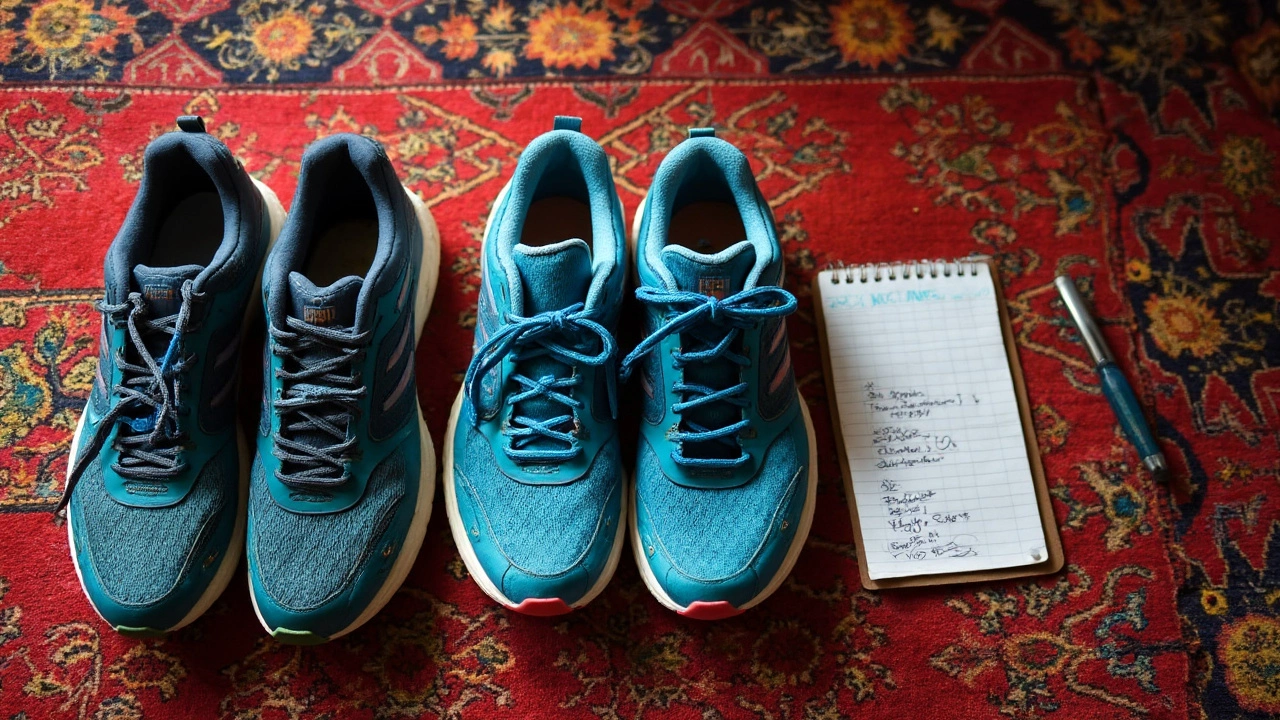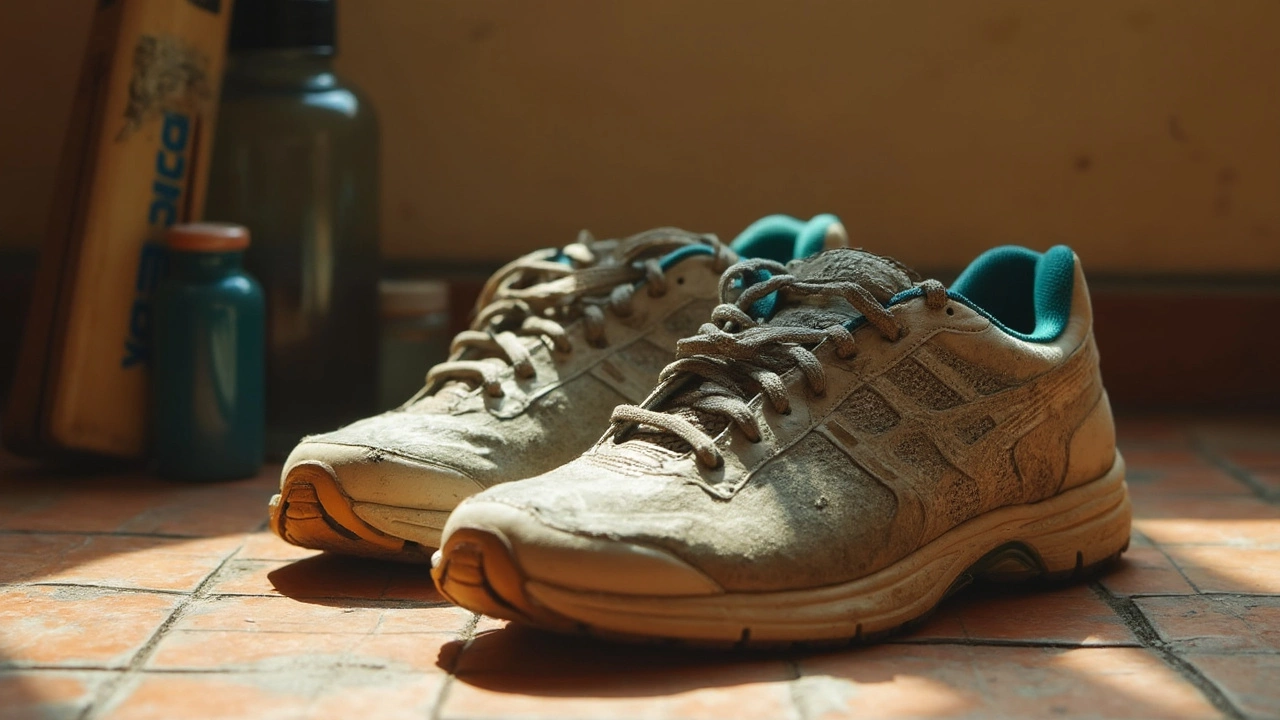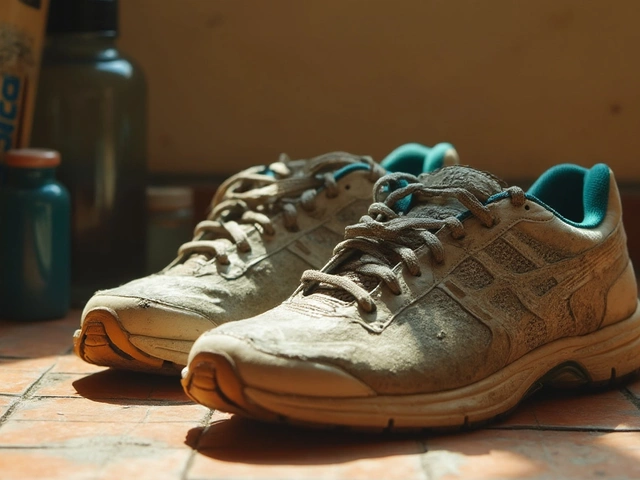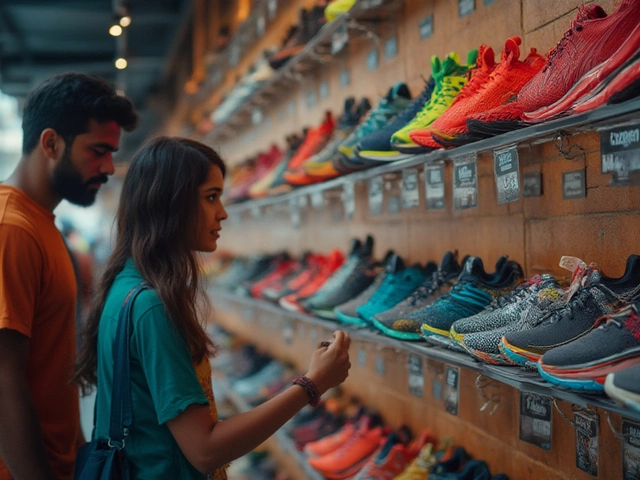Ever wondered if your running shoes are really done for, or if you’re just being paranoid because you read a blog? You’re not alone. Most runners end up guessing and hope their knees won’t pay the price. Here’s the deal—shoes don’t come with a check engine light. So, you need to know the signs yourself.
If your joints start aching after a run, or you see weird patterns on the outsole, don’t just shrug it off. That twinge in your knee or the flattening under your foot is your body’s low-battery signal—listen up. Shoes are sneaky; they can look decent on the outside but be dead on the inside. The midsole, the place that absorbs shocks, often gives out before anything looks wrong. If you press the foam and it barely bounces back, it’s probably time to say goodbye.
- Why Shoe Lifespan Isn’t Just About Mileage
- The Easy Visual Cues: Soles, Uppers, and More
- How Your Body Warns You Before Your Shoes Do
- Spotting Sneaky Signs: Bends, Smells, and Cushioning Failures
- Shoe Brands, Surfaces, and Runners—Why Your Mileage May Vary
- Pro Tips to Make Your Shoes Last Longer (And Stay Safe)
Why Shoe Lifespan Isn’t Just About Mileage
Ever see advice about replacing running shoes every 300–500 miles? It sounds simple, but there’s way more to the story. That number is just a rule of thumb—it doesn’t work for every runner or every pair of shoes. You could hit 400 miles and your shoes might feel great, or hit 200 and they’re toast.
The truth is, different things chip away at shoe life. Let’s break it down:
- Running shoes break down faster if you’re heavier, run on rough trails, or have a heavy stride. That’s just physics.
- If you run on pavement, your shoes usually wear quicker than if you’re on grass or a track.
- Those who rotate shoes (using two pairs) can stretch the life of each pair, because the cushioning gets time to rebound between runs.
- Even how you wash and dry them makes a difference—high heat wrecks glue and foam fast.
Check this out—a study by the American Academy of Podiatric Sports Medicine showed that midsole cushioning in running shoes broke down anywhere between 250 and 500 miles, depending on running style and environment. And here’s a useful table comparing real-life running situations:
| Runner/Shoe Factor | Faster Wear | Slower Wear |
|---|---|---|
| Heavier Runner | Yes | No |
| Rough Surface | Yes | No |
| Pavement Running | Yes | No |
| Shoe Rotation | No | Yes |
| Machine Drying | Yes | No |
And honestly, shoes can "die" on the inside even if the treads look okay. The cushioning and support are what count—not just the rubber on the sole. So if you trust just the mileage, your feet might be in for a rough ride. Pay more attention to the feel and performance during your runs, not only what your tracker app says.
The Easy Visual Cues: Soles, Uppers, and More
Want a dead giveaway your running shoes are shot? Start with the outsole. Flip your shoe over and check the bottom—are the treads smooth or uneven, especially around the heel and forefoot? Some survey data says most runners see tread wear before any other problem. If you notice the bottom looks totally flat or the grip’s missing on one side, those shoes are probably overdue for retirement.
Now, take a look at the midsole. This is where most runners miss trouble because the white foam can get squished or creased, while the shoe still looks normal from above. Press on the side of the midsole with your thumb. If it’s hard as a rock or it stays compressed, the shock absorption is pretty much gone. You might even see wrinkles or deep lines running through the foam—another big warning sign.
The upper part of the shoe tells a different story. If you see holes, stretched mesh, or fraying fabric near your pinky toe, it’s a sign the support structure isn’t working anymore. Laces that dig into your foot or upper material that collapses are all red flags. The shoe should hug your foot, not flop around like an old slipper.
- Check for outsole wear and lost treads, especially in high-impact spots.
- Press and inspect the midsole for stubborn creases or a loss of bounce.
- Don’t ignore upper damage like holes, loose stitching, or misshapen areas.
If any of these check out, there’s a good chance your running shoes are past their prime. Even small changes in the way your shoes look or feel can lead to bigger problems if you keep running in them. These visual cues are quick to spot and can save you from a world of hurt down the road.
How Your Body Warns You Before Your Shoes Do
Your body is probably the loudest alarm when it comes to running shoes breaking down. You might not spot the problem in the mirror, but you’ll feel it in your bones—literally. If you start noticing new aches or pains in your feet, ankles, knees, or hips after running, don’t just blame it on a tough workout. Sometimes it’s your shoes screaming for retirement.
Pay attention if you suddenly feel sore after easy runs or if a familiar nagging pain returns out of nowhere. Soreness that hangs around, unusual blisters, or hot spots can all mean your shoes have lost their support or cushioning. Another red flag is tenderness on the bottom of your feet, especially near your heels or arches, which points to worn-out shock absorption.
Watch for these common signals:
- Pain that starts after you run and goes away with rest (classic sign the cushioning is dead)
- A sudden uptick in shin splints or ankle soreness, even though your routine hasn’t changed
- Your feet feel tired much sooner than before, or you start feeling the ground more than usual
One thing runners often miss: even a slight limp or change in your stride can be your body’s way of protecting itself from a worn-down shoe. If you catch yourself adjusting your landing or posture without realizing it, your shoes might be the hidden villain.
Bottom line—don’t write off new aches as just “getting older” or “bad luck.” When your body throws these warning signs, it’s time to check those shoes. Ignoring the signs can turn a small ache into a real injury. Save your body, check your shoes first.

Spotting Sneaky Signs: Bends, Smells, and Cushioning Failures
It’s easy to miss the subtle warnings that your running shoes are overdue for retirement. Let’s break down a few lesser-known ways your shoes show their age—none of which require a microscope or lab tech degree.
- Bend Test: Hold your shoe at both ends and try to bend it in half. Newer shoes should resist a bit. If your shoe folds like a taco, your midsole support is toast. Overly flexible shoes aren’t just weird—they’re a real risk for sore joints and injuries.
- That Funky Smell: A bit of odor is normal, but a permanent, strong stink that won’t wash out even with baking soda is a hint the interior has broken down. That smell isn’t just gross; it’s a sign bacteria has eaten away at the lining and foam, which means the materials aren’t protecting your feet like they should.
- Cushioning Failures: Check the midsole—the squishy part between your foot and the outsole. Press your thumb into it. If there’s barely any give, or if you see deep wrinkles or compressed areas, the shock absorption is gone. No bounce equals no protection against pounding.
Here’s a wild stat: Brooks Running did a durability test and found midsoles can lose up to 40% of their shock absorption after just 300 miles. You’re basically running on cardboard past that point.
| Sneaky Sign | What It Means |
|---|---|
| Shoe bends too easily | Midsole worn out, poor stability |
| Persistent bad odor | Interior lining/foam broken down |
| Midsole has deep creases | No shock absorption left |
Dr. Casey Kerrigan, a sports medicine expert, says,
"Most runners retire shoes based on looks, but in reality, cushioning and support give out long before you see obvious damage."
Bottom line? Trust the bend test, your nose, and the feel of the cushioning. If your running shoes are failing any of these checks, it’s your sign to look for a fresh pair before your body starts complaining.
Shoe Brands, Surfaces, and Runners—Why Your Mileage May Vary
Ever wonder why someone says their shoes lasted 400 miles, while yours crashed out at 250? It’s not just bad luck. Here’s how the shoe game really works.
Brands have their quirks. Some, like Asics Gel Kayano or Brooks Ghost, are built with more foam and beefier outsoles, so they usually stick around for more miles. Lighter shoes, like Nike Free or Saucony Kinvara, feel fast and snappy but often wear out quicker because there's less material for cushioning and grip.
Surface matters big time. If you’re pounding concrete every run, your shoes will suffer. Trails and soft grass eat up less shoe-cushion, so you’ll get more life out of them. Tread wear is brutal on pavement. Even if the upper is fine, the bottom gets shredded fast on rough roads.
No two runners are the same, either. Heavier runners compress the midsole faster. If you’ve got a neutral stride, your shoes may last longer. Overpronators—folks whose foot rolls inward a lot—wear the inside edge faster, especially with a running shoes model that isn’t built for stability. Where you land on your foot (heel, midfoot, or forefoot) also chews up different parts of the sole.
- If you rotate pairs and give each shoe a day to decompress, they’ll last longer.
- Check if your favorite brand makes models matched to your running style or terrain.
- Log your runs: writing down distance and where you run gives you clues about your shoe’s real lifespan.
So next time you’re eyeing a flashy new release, remember—your actual shoe mileage might be way more personal than you’d think. The make, the ground, and your body all play a part.
Pro Tips to Make Your Shoes Last Longer (And Stay Safe)
If you’re tired of blowing your budget on new shoes, there are real ways to stretch that “fresh pair” feeling. But, just to be clear—don’t cheap out on safety. Saving money is great, but your knees and feet have to come first.
- Rotate your running shoes. Most serious runners have at least two pairs in rotation. This gives each pair a chance to decompress, meaning the cushion gets back to shape and lasts longer.
- Clean off dirt and mud right after your runs. Gunk breaks down fabric and glue faster than you think. Use a brush or just rinse them lightly—don’t toss them in a hot dryer or washing machine. Heat warps the materials and kills the cushioning.
- Only wear your shoes for running. Don’t mow the lawn, walk the dog, or do chores in your running pair. Every extra mile—running or not—burns through the cushion and outsole.
- Untie your laces when taking them off or putting them on. Yanking your foot out every time stretches out the heel counter and can ruin the fit.
- Store your shoes somewhere cool and dry. Heat and humidity break down glue and foam. Never leave them in a hot car or near a heater.
If you want the numbers, check this table—most major brands admit that their midsoles lose 20-30% of shock absorption after just 250 miles, but careful users can nearly double that mileage.
| Brand | Typical Lifespan (Miles) | With Good Care (Miles) |
|---|---|---|
| Asics | 300-500 | 500-600 |
| Brooks | 300-500 | 500-650 |
| Nike | 300-400 | 450-550 |
| New Balance | 300-500 | 500-600 |
Bottom line? Small habits really do boost your running shoes lifespan. That’s more money in your pocket and fewer aches and pains down the road.





